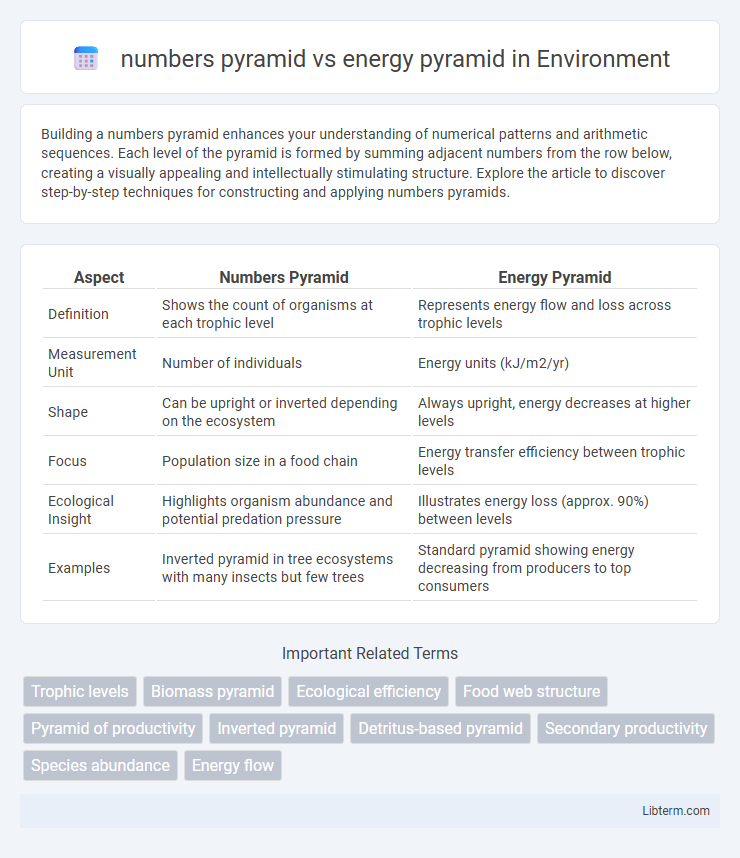Building a numbers pyramid enhances your understanding of numerical patterns and arithmetic sequences. Each level of the pyramid is formed by summing adjacent numbers from the row below, creating a visually appealing and intellectually stimulating structure. Explore the article to discover step-by-step techniques for constructing and applying numbers pyramids.
Table of Comparison
| Aspect | Numbers Pyramid | Energy Pyramid |
|---|---|---|
| Definition | Shows the count of organisms at each trophic level | Represents energy flow and loss across trophic levels |
| Measurement Unit | Number of individuals | Energy units (kJ/m2/yr) |
| Shape | Can be upright or inverted depending on the ecosystem | Always upright, energy decreases at higher levels |
| Focus | Population size in a food chain | Energy transfer efficiency between trophic levels |
| Ecological Insight | Highlights organism abundance and potential predation pressure | Illustrates energy loss (approx. 90%) between levels |
| Examples | Inverted pyramid in tree ecosystems with many insects but few trees | Standard pyramid showing energy decreasing from producers to top consumers |
Introduction to Ecological Pyramids
Ecological pyramids represent the distribution of energy, biomass, or numbers across trophic levels in an ecosystem, with the numbers pyramid specifically illustrating the population count of organisms at each level. The numbers pyramid often varies in shape depending on organism size and reproductive rates, sometimes appearing inverted when fewer producers support numerous consumers. In contrast, the energy pyramid consistently depicts energy flow from producers to apex consumers, highlighting the decrease in available energy due to metabolic losses at each successive trophic level.
Defining the Numbers Pyramid
The numbers pyramid illustrates the population count at each trophic level, showing how many individual organisms exist from producers to apex predators. Unlike the energy pyramid, which emphasizes energy flow and biomass, the numbers pyramid focuses solely on organism quantity, highlighting the potential for population dynamics within ecosystems. This pyramid can be upright or inverted depending on the reproductive rates and sizes of organisms at each level.
Explaining the Energy Pyramid
The energy pyramid illustrates the flow of energy through trophic levels in an ecosystem, demonstrating that energy decreases by approximately 90% with each successive level due to metabolic processes and heat loss. Producers at the base convert solar energy into biomass, supporting primary consumers and higher trophic levels with progressively less available energy. Unlike the numbers pyramid, which focuses on organism count, the energy pyramid quantifies energy transfer efficiency and ecosystem productivity.
Key Differences Between Numbers and Energy Pyramids
Numbers pyramids illustrate the population size of organisms at each trophic level, often showing the count of individuals, whereas energy pyramids depict the flow of energy through each trophic level measured in units such as kilocalories or joules. Unlike numbers pyramids that can be inverted or irregular depending on species size, energy pyramids are always upright, reflecting the consistent loss of energy (approximately 90%) as it transfers between levels due to metabolic processes. Key differences also include that numbers pyramids focus on quantity, while energy pyramids emphasize energy transfer efficiency and ecosystem productivity.
Structural Representation: Numbers vs. Energy
Numbers pyramids illustrate the population count at each trophic level, highlighting the quantity of organisms regardless of size or biomass, often appearing inverted. Energy pyramids depict the flow of energy through trophic levels, always upright due to the law of thermodynamics, showing energy loss as heat from one level to the next. This structural representation emphasizes energy transfer efficiency, contrasting with numbers pyramids that focus on organism abundance rather than energy content.
Ecological Significance of Each Pyramid Type
Numbers pyramids illustrate the population size at each trophic level, emphasizing species abundance and community structure, which helps in understanding predator-prey relationships and population dynamics. Energy pyramids depict energy flow through trophic levels, revealing energy loss due to metabolic processes and the efficiency of energy transfer in ecosystems, crucial for assessing ecosystem productivity and sustainability. Both pyramid types highlight ecological balance but focus respectively on population metrics and energy distribution, offering comprehensive insights into ecosystem functioning.
Examples in Real Ecosystems
Numbers pyramids illustrate the population count at each trophic level, such as the vast number of phytoplankton supporting fewer zooplankton in aquatic ecosystems. Energy pyramids represent the flow of energy through trophic levels, exemplified by the decreasing energy transfer from grass to herbivores and then to carnivores in a savanna ecosystem. Unlike energy pyramids, numbers pyramids can be inverted, as seen when a single tree supports numerous insects in a forest ecosystem.
Limitations of Numbers Pyramids
Numbers pyramids often fail to accurately represent energy flow in ecosystems because they only account for the population size without considering organism size or biomass. These pyramids can be misleading when large-bodied producers at the base support fewer, larger consumers higher up, causing inverted or irregular shapes. Additionally, numbers pyramids do not reflect the energy transfer efficiency or the amount of energy lost at each trophic level, limiting their ecological interpretability compared to energy pyramids.
Advantages of Energy Pyramids in Ecology
Energy pyramids clearly illustrate the flow of energy through trophic levels, highlighting energy loss at each stage and promoting better understanding of ecosystem efficiency. They provide a more accurate representation of biomass and energy transfer than numbers pyramids, which can be misleading due to organism size variability. Energy pyramids assist ecologists in identifying the sustainability of ecosystems and in predicting the impacts of environmental changes on energy dynamics.
Conclusion: Choosing the Right Pyramid for Analysis
Selecting between a numbers pyramid and an energy pyramid depends on the ecological study's goals, as the numbers pyramid highlights organism population size while the energy pyramid emphasizes energy flow and ecosystem productivity. Energy pyramids provide deeper insights into trophic efficiency and energy loss across levels, making them ideal for understanding ecosystem dynamics and sustainability. Numbers pyramids are useful for assessing species abundance and population trends but may misrepresent ecological importance due to varying body sizes and energy use.
numbers pyramid Infographic

 libterm.com
libterm.com